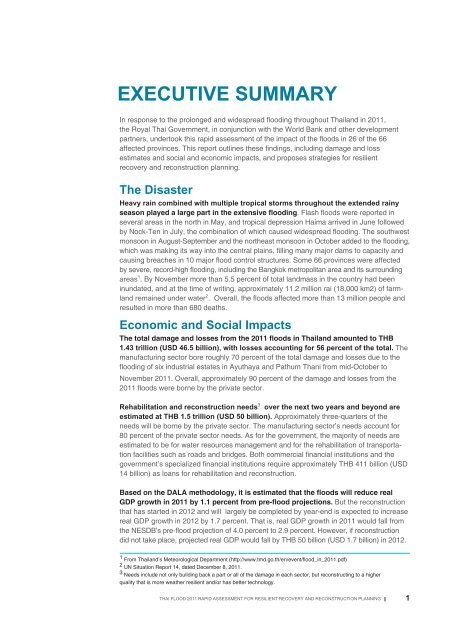Rapid Assessment for Resilient Recovery and ... - GFDRR
Rapid Assessment for Resilient Recovery and ... - GFDRR
Rapid Assessment for Resilient Recovery and ... - GFDRR
You also want an ePaper? Increase the reach of your titles
YUMPU automatically turns print PDFs into web optimized ePapers that Google loves.
EXECUTIVE SUMMARY<br />
In response to the prolonged <strong>and</strong> widespread flooding throughout Thail<strong>and</strong> in 2011,<br />
the Royal Thai Government, in conjunction with the World Bank <strong>and</strong> other development<br />
partners, undertook this rapid assessment of the impact of the floods in 26 of the 66<br />
affected provinces. This report outlines these findings, including damage <strong>and</strong> loss<br />
estimates <strong>and</strong> social <strong>and</strong> economic impacts, <strong>and</strong> proposes strategies <strong>for</strong> resilient<br />
recovery <strong>and</strong> reconstruction planning.<br />
The Disaster<br />
Heavy rain combined with multiple tropical storms throughout the extended rainy<br />
season played a large part in the extensive flooding. Flash floods were reported in<br />
several areas in the north in May, <strong>and</strong> tropical depression Haima arrived in June followed<br />
by Nock-Ten in July, the combination of which caused widespread flooding. The southwest<br />
monsoon in August-September <strong>and</strong> the northeast monsoon in October added to the flooding,<br />
which was making its way into the central plains, filling many major dams to capacity <strong>and</strong><br />
causing breaches in 10 major flood control structures. Some 66 provinces were affected<br />
by severe, record-high flooding, including the Bangkok metropolitan area <strong>and</strong> its surrounding<br />
areas 1 . By November more than 5.5 percent of total l<strong>and</strong>mass in the country had been<br />
inundated, <strong>and</strong> at the time of writing, approximately 11.2 million rai (18,000 km2) of farml<strong>and</strong><br />
remained under water 2 . Overall, the floods affected more than 13 million people <strong>and</strong><br />
resulted in more than 680 deaths.<br />
Economic <strong>and</strong> Social Impacts<br />
The total damage <strong>and</strong> losses from the 2011 floods in Thail<strong>and</strong> amounted to THB<br />
1.43 trillion (USD 46.5 billion), with losses accounting <strong>for</strong> 56 percent of the total. The<br />
manufacturing sector bore roughly 70 percent of the total damage <strong>and</strong> losses due to the<br />
flooding of six industrial estates in Ayuthaya <strong>and</strong> Pathum Thani from mid-October to<br />
November 2011. Overall, approximately 90 percent of the damage <strong>and</strong> losses from the<br />
2011 floods were borne by the private sector.<br />
Rehabilitation <strong>and</strong> reconstruction needs 3 over the next two years <strong>and</strong> beyond are<br />
estimated at THB 1.5 trillion (USD 50 billion). Approximately three-quarters of the<br />
needs will be borne by the private sector. The manufacturing sector’s needs account <strong>for</strong><br />
80 percent of the private sector needs. As <strong>for</strong> the government, the majority of needs are<br />
estimated to be <strong>for</strong> water resources management <strong>and</strong> <strong>for</strong> the rehabilitation of transportation<br />
facilities such as roads <strong>and</strong> bridges. Both commercial financial institutions <strong>and</strong> the<br />
government’s specialized financial institutions require approximately THB 411 billion (USD<br />
14 billion) as loans <strong>for</strong> rehabilitation <strong>and</strong> reconstruction.<br />
Based on the DALA methodology, it is estimated that the floods will reduce real<br />
GDP growth in 2011 by 1.1 percent from pre-flood projections. But the reconstruction<br />
that has started in 2012 <strong>and</strong> will largely be completed by year-end is expected to increase<br />
real GDP growth in 2012 by 1.7 percent. That is, real GDP growth in 2011 would fall from<br />
the NESDB’s pre-flood projection of 4.0 percent to 2.9 percent. However, if reconstruction<br />
did not take place, projected real GDP would fall by THB 50 billion (USD 1.7 billion) in 2012.<br />
1 From Thail<strong>and</strong>’s Meteorological Department (http://www.tmd.go.th/en/event/flood_in_2011.pdf)<br />
2 UN Situation Report 14, dated December 8, 2011.<br />
3 Needs include not only building back a part or all of the damage in each sector, but reconstructing to a higher<br />
quality that is more weather resilient <strong>and</strong>/or has better technology.<br />
THAI FLOOD 2011 RAPID ASSESSMENT FOR RESILIENT RECOVERY AND RECONSTRUCTION PLANNING<br />
1

















